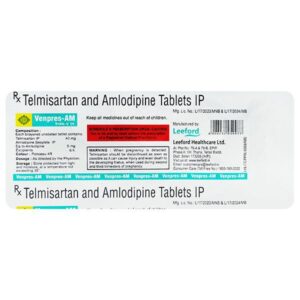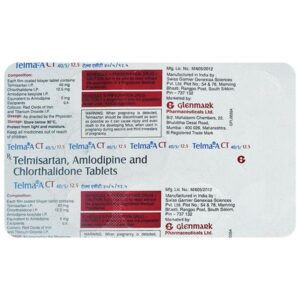AMLODIPINE + CHLORTHALIDONE + TELMISARTAN
Amlodipine: Amlodipine is a medication that belongs to the class of drugs called calcium channel blockers. It is primarily used to treat high blood pressure (hypertension) and chest pain (angina). Amlodipine works by relaxing and widening the blood vessels, allowing for easier blood flow and reducing the workload on the heart.
In the case of hypertension, Amlodipine helps to lower blood pressure by inhibiting the influx of calcium into the smooth muscle cells lining the blood vessels. By doing this, it prevents the contraction of these muscle cells, which promotes vasodilation and lowers blood pressure.
For angina, Amlodipine increases the supply of oxygen to the heart muscle by widening the coronary arteries and reducing the demand for oxygen by the heart. This helps to relieve chest pain and can prevent future episodes of angina.
Amlodipine is typically taken orally once per day, with or without food. The dosage may vary depending on the individual’s condition and response to the medication. It is important to follow the prescribed dosage instructions provided by a healthcare professional.
Common side effects of Amlodipine may include dizziness, headache, flushing, fatigue, swelling in the ankles or feet, and nausea. These side effects are generally mild and temporary. However, if any of these side effects persist or become severe, it is important to consult a healthcare provider.
Rare, but potentially serious side effects may include allergic reactions (e.g., rash, itching, swelling), rapid or irregular heartbeat, severe dizziness, and difficulty breathing. If any of these severe side effects occur, immediate medical attention should be sought.
As with any medication, it is important to inform a healthcare professional about any existing medical conditions, allergies, or medications being taken, as they may interact with Amlodipine or affect its effectiveness. Only a healthcare professional can determine if Amlodipine is appropriate for an individual and provide specific dosage instructions.
Chlorthalidone: Chlorthalidone is a diuretic medication primarily used in the treatment of high blood pressure (hypertension) and fluid retention (edema) caused by various conditions such as heart failure, liver disease, and kidney disease.
Mechanism of Action:
Chlorthalidone belongs to the thiazide diuretic class of drugs. It works by increasing the excretion of water and electrolytes, such as sodium and chloride, through the kidneys. This reduces the volume of fluid in the blood vessels, leading to decreased blood pressure and relief of edema.
Dose:
The typical starting dose of chlorthalidone for hypertension is 25 mg per day, taken orally as a single dose. The dose may be increased gradually up to 50 mg per day or even higher if necessary for blood pressure control. For edema, the dosage may be higher, starting at 50 mg per day and increasing as needed.
Side Effects:
Common side effects of chlorthalidone may include:
1. Frequent urination
2. Increased thirst
3. Dizziness or lightheadedness
4. Headache
5. Muscle cramps or weakness
6. Nausea or vomiting
7. Low potassium levels (hypokalemia)
8. Low sodium levels (hyponatremia)
9. Increased sensitivity to sunlight
Less common but more serious side effects may include:
1. Allergic reactions (rash, itching, swelling, severe dizziness, difficulty breathing)
2. Toxic epidermal necrolysis (rare but severe skin reactions)
3. Pancreatitis (inflammation of the pancreas)
4. Severe electrolyte imbalances
5. Worsening kidney function or kidney stones
6. Erectile dysfunction
It’s important to follow your healthcare provider’s instructions and report any concerning side effects. Some side effects, particularly electrolyte imbalances, may require regular monitoring through blood tests. Chlorthalidone may also interact with other medications and conditions, so it’s important to inform your doctor about all your current medications and medical history before starting this drug.
Telmisartan: Telmisartan is a drug that belongs to a class of medications known as angiotensin receptor blockers (ARBs). It is primarily used for the treatment of hypertension (high blood pressure) in adults.
The mechanism of action of telmisartan involves blocking the action of angiotensin II, a hormone that causes blood vessels to constrict. By blocking the angiotensin II receptor, telmisartan helps to relax and widen the blood vessels, which in turn lowers blood pressure. This action also helps to reduce the workload on the heart and improve blood flow.
The typical starting dose of telmisartan for hypertension is 20-40 mg once daily, which can be increased to a maximum dose of 80 mg per day if necessary. It can be taken with or without food.
Some common side effects of telmisartan include dizziness, headache, back pain, sinusitis, sore throat, and an increased risk of upper respiratory tract infections. Less common but more serious side effects can include kidney problems, allergic reactions, and low blood pressure (especially in people who are already dehydrated or have low blood volume).
It is important to note that telmisartan should not be used during pregnancy as it may harm the unborn baby. It may also interact with certain medications, so it is essential to inform your healthcare provider about all the drugs you are currently taking before starting telmisartan.
As always, it is recommended to consult with a healthcare professional or pharmacist for personalized advice and guidance regarding the use of telmisartan.



